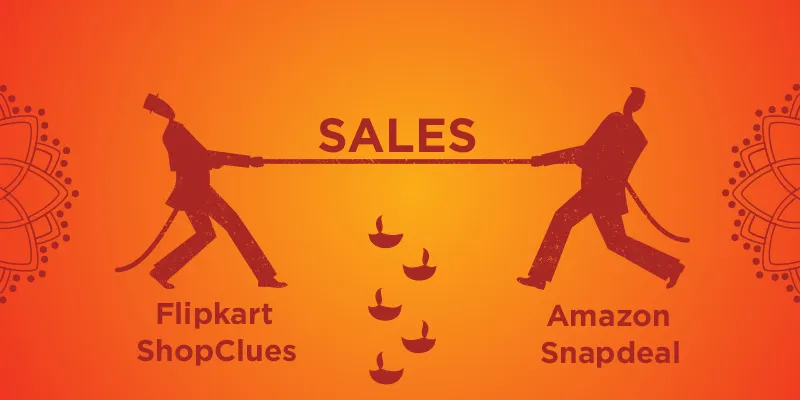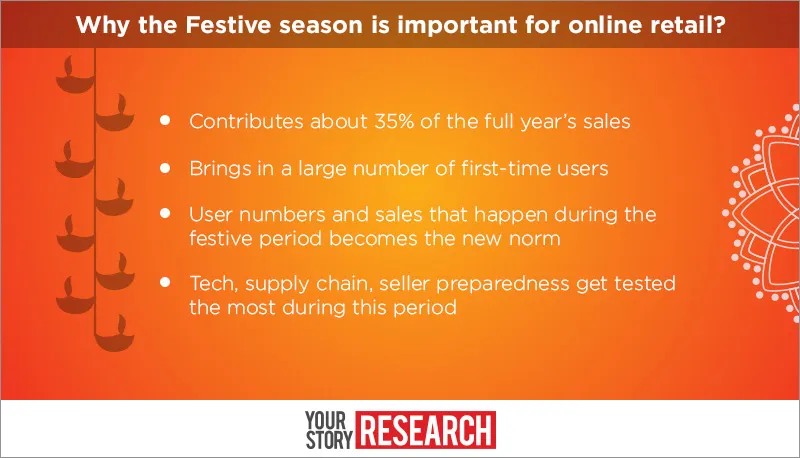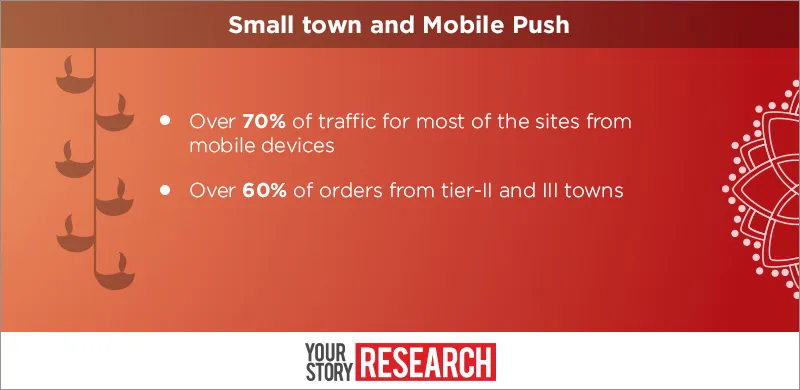Online retail delivers a blockbuster this Diwali

Cement, pressure cookers, mithai and even cow dung cakes—these were some of the bestsellers for online retail companies this festive season. Big online marketplaces did unleash deep discounts of up to 90 percent and newspapers, as expected, were filled with full-page ads. But, the dominant themes this season were larger assortment of goods and a majority of consumers coming from smaller towns.
The pre-Diwali period—around 60 days—is the most important period for online retail in India. Rahul Taneja, Vice President of Category Management at Snapdeal says, “In under three months, you do 35 percent of the year’s business. It is a significant season.” Radhika Aggarwal of ShopClues concurs with this calculation.
Flipkart is targeting over $10 billion in GMV by around March next year and Snapdeal boss Kunal Bahl had said in August that his firm would be the No. 1 e-tailer in the country in March 2016. If this seems like a large number, remember that just a few days ago Alibaba created a new record in online sales by selling $14.33 billion worth of goods during Singles Day, the annual shopping frenzy started by the Chinese e-commerce giant. Coming back to the Indian Goliaths, if we assume that Flipkart and Snapdeal meet their targets then their combined sales will be over $20 billion. Add another $5 billon for rest of online retail (Amazon has never officially disclosed its India sales numbers) and we have a $25-billion online retail industry by March 2016. That would mean around $8 billion worth of goods, according to the percentage provided by online retailers, were sold during the season.
No wonder then that online retailers work Diwali to Diwali.

All the marketplaces YourStory spoke to say this Diwali was better than expected, an assessment backed by experts. “This year was make-or-break for a lot of e-commerce players. It has been a good festive season for them,” says Arvind Singhal, Chairman of Retail Advisory, Technopak.
Flipkart recorded sales of $300 million during its five-day Big Billion Days sale in October, while Snapdeal's sales grew over three times compared to last Diwali. ShopClues sold 4.5 million items in October, two times higher compared to regular months. Amazon said sales grew about 10 times for its sellers during the five-day Great Indian Sale in October.
Interesting trends
While Flipkart initially faced some technical glitches, sales were smooth across sites for the festive sale period—something the sites are proud of. Amit Agarwal, VP and Country Manager of Amazon India says, “We were able to serve customers without any technical glitches. Customers loved the seamless experience throughout the sale where thousands of customers made purchase every minute through the day.” Snapdeal saw 2,00,000 concurrent users on its site during the peak and according to Rahul, the web and mobile sites and the mobile app gave no trouble.
However, one of the most interesting trends was the explosion in categories. Radhika of ShopClues says that discounting was not the only hook this time. “The consumers bought a wider range of products,” she says, adding, “Last year’s sale was driven by electronics and appliances. This year, everything from daily utilities to pooja items found takers. One of our top sellers was the havan kund with cow dung cakes.” ShopClues saw over 100 million visitors during October.
Snapdeal, too, had some interesting bestsellers in the form of cement and pressure cookers. But, mobiles, personal grooming products, TVs, furniture and fashion were the top categories for the site.
For Amazon, Consumer Electronics, Fashion and Home & Kitchen were the top categories. The site sold three times the number of mobile phones compared to last Diwali. It, too, had some unique top products. It sold 33,000 units of Ganesh vegetable chopper and 20 tonnes of mithai including rasgullas, gulab jamuns, son papdi and laddu.

The demand for a wider assortment is a reflection of the number of categories the marketplaces have brought online since last Diwali. For instance, Flipkart launched the furniture category this August. Amazon added around 4,000 products a day on average. ShopClues launched a Rs 150-ironbox and a 16-inch LED TV for under Rs 5,000, among other products. “Our planning was very extensive, right down to sub-category level. Our analytics helped us figure out what our top sellers would be and we informed our sellers in advance,” says Radhika.
This greater supply and demand for a larger variety of goods is a sign of maturity. “It shows the market has acquired much more depth in terms of geography, age and income profiles and width in terms of categories,” says Technopak’s Arvind.
Mobile traffic and small towns drive growth
The past many months have made it quite clear that consumers accessing sites through smartphones are pushing growth for e-tailers. This became even clearer during the festive period. Ankit Nagori, Chief Business Officer at Flipkart said 75 percent of traffic is through mobile. For Amazon, Snapdeal and ShopClues that number stood at 70 percent. Flipkart recently re-launched its mobile site, after discontinuing it in March. Snapdeal launched Snap-lite in response.

A high percentage of overall users are from non-metros for all the sites. “While metros like Bengaluru, Delhi and Mumbai were the leading cities in terms of the sales, Flipkart also saw huge surge of interest from Tier-II cities with Nagpur, Indore, Coimbatore, Vishakhapatnam and Jaipur leading in sales,” says Ankit of Flipkart.
Amazon’s sellers received orders from 2,100 towns. Over 65 percent of orders on the site were from Tier-II and III towns like Rajkot, Kota, Dhanbad, Thrissur, Surat, Diu and Jamnagar.
For Snapdeal, over 60 percent of sales were from such small towns. “We even got orders from six pin codes in the Lakshadweep Islands,” says Rahul of Snapdeal.
Small towns contributed to about 70 percent of orders on ShopClues. “While overall visits went up four times from last year, Tier-III visits went up 10 times and that is almost completely through mobile devices,” says Radhika.
On-time logistics, mostly
Last year, chaos at airports caused massive delays when it came to deliveries. Flipkart says this time around they had a 99.5 percent on-time delivery record for the Big Billion Days orders. However, during the sale, a number of customers had taken to Twitter to vent their frustration on faraway delivery dates. Amazon’s Amit says they were shipping 60 percent of orders within six hours of the order being placed.
Much of this was made possible due to the drastic expansion in warehouses and the focus on surface transport rather than air cargo.
So, does all the good news mean that online sites have no more issues to worry about? Not necessarily. It is an undeniable fact that discount and deals are still the top attractions for consumers. “Consumers are doing price comparison and are portal-agnostic. This should be a cause of worry. Brand awareness is not leading to brand stickiness,” says Arvind of Technopak. He says service is no longer a differentiator, as most portals are providing similar levels of on-site and delivery services.
It is the category spread that will begin to matter even more, as this Diwali proved. Arvind says unique products and private labels will be the way to go for these sites. The question is how much more investor money will they need to burn to finally gain customer loyalty.







